
Pull-ups primarily target the back muscles, especially the lats, contributing to a more developed and broader back.1 Variations of pull-ups can also impact the muscles worked, enhancing their effectiveness as a compound exercise for the back.
However, there’s several other muscles at play and the various hand positions, neutral grip vs wide grip vs narrow grip, as well as underhand vs overhand, plays a role in targeting different muscles.
With all of these options, it can be hard to know which variation is best and why. Therefore, this article compares each pull-up types in detail and explains which variations engage which muscles so you can decide which is best for your particular goals.
And if you can’t do an unassisted pull-up yet, we’ll provide some proven tips and tricks that will get your chin above the bar in no time!
Muscles Targeted by Pull-Ups
Pull-ups are a must-do bodyweight back exercise, and for good reason. Few other exercises demand so much from the upper and lower back muscles, arm muscles, and core.
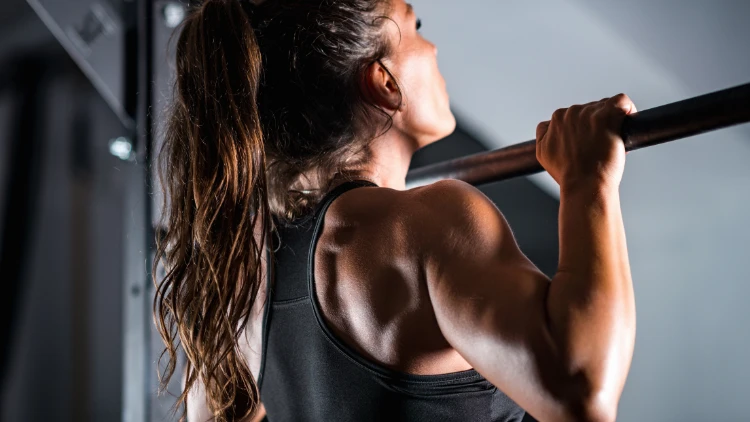
Source: microgen via Canva.com2
For many lifters, completing their first pull-up is an important milestone in their fitness journey. Let’s look at the muscles that come into play in every pull-up variation:
Back & Spinal Muscles (Latissimus Dorsi & Erector Spinae)
When asked about the muscles targeted by pull-ups, most people typically mention the latissimus dorsi. As shown in the image above, the largest back muscles are the lats (latissimus dorsi) and spinal erectors (erector spinae).
Most people have stronger push muscles than pull muscles and consequently find push-ups easier than pull-ups.3 This is unfortunate, because the back muscles are huge! Strengthening them improves overall strength and speeds up the metabolism dramatically.
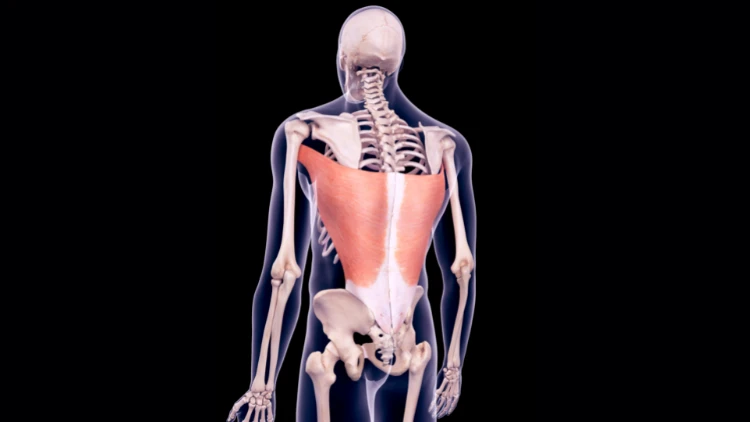
Source: Science Photo Library via Canva.com4
Discover the differences between pull-ups and push-ups.
The lats and spinal erectors overlap, with the lats on top and the spinal erectors below. While the lats help move the shoulder blades, assist in breathing, and play a key role in all upper body pulling movements, the spinal erectors are mainly responsible for moving the spine and maintaining good posture.
Shoulder & Neck Muscles (Infraspinatus & Trapezius)
Research indicates that pull-ups can help prevent shoulder injuries.5 This is great news, because the shoulders are one of the most injury-prone joints.
When performing pull-ups, the traps (trapezius), found across the upper back in a shawl-like shape, and the infraspinatus muscles, found at the backs of the shoulders, are both key players.
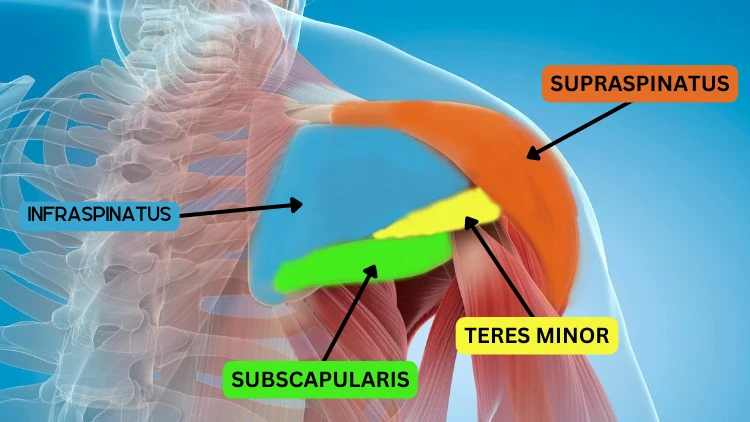
Source: Science Photo Library via Canva.com6
The traps have three sections, each with distinct roles. The upper traps allow an individual to shrug their shoulders and move their neck.
The middle traps stabilize the shoulders and help retract the shoulder blades. Lastly, the lower traps stabilize the spine during many movements and allow an individual to ‘un-shrug’ their shoulders.
Together, these three sections can provide immense benefit to the neck, shoulders, and spine when strong, or cause immense pain in those areas when weak.
All Shoulder and Neck Muscles Worked
- Infraspinatus
- Trapezius
- Deltoids
- Rhomboids
- Subscapularis
- Teres major
Arm Muscles (Biceps Brachii & Brachioradialis)
Finally, pull-ups work the arms muscles. While most people want lean, strong arms, keep in mind that the primary drivers in a pull-up movement are the muscles in the back and trunk.
The arms are important as well, but they play second fiddle.
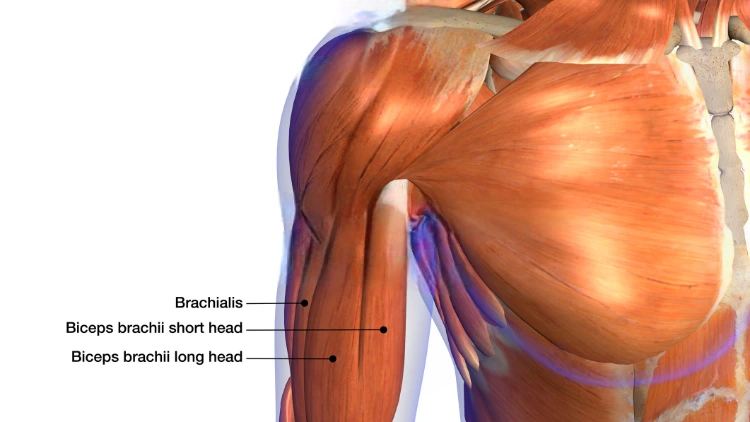
Source: Hank Grebe via Canva.com7
The biceps (biceps brachii) muscles bend the elbows and aid in outward rotation of the forearms. The forearm (brachioradialis) muscle bends the elbows when the forearms are internally rotated, with the palms facing down.
Both muscles engage at the beginning and end of a pull-up to help a lifter complete a full range of motion in the movement. It’s worth noting that the eccentric (lowering) phase of all pull-up variations engages the muscles in the arms more than the concentric (lifting) phase of the movement.8
Slowing down the lowering phase of any pull-up variation can help lifters develop stronger arm muscles.
All Arm Muscles Worked
- Biceps Brachii
- Brachioradialis
- Triceps
Types of Pull Ups & Muscles Worked
While all six of these muscles or muscle groups come into play in every pull-up variation, some types of pull-ups emphasize certain muscles over others. This can be helpful in the development of well-rounded strength, and it can also help lifters achieve specific aesthetic or performance goals.
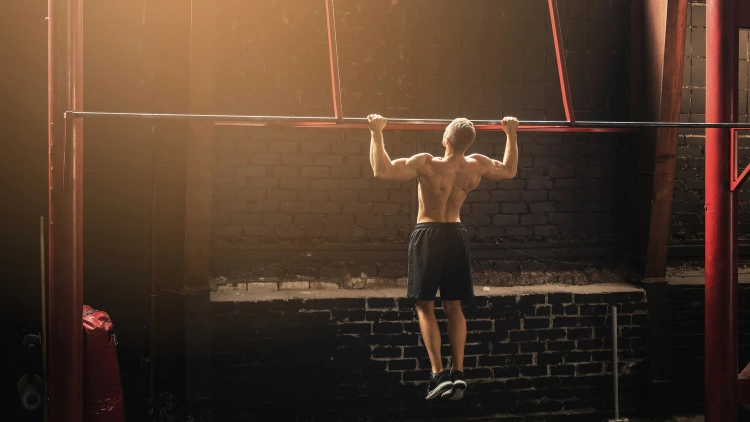
Source: Jun via Canva.com9
Let’s delve deeper into the muscles targeted by pull-ups.
Wide Grip Pull Ups Muscles Worked
To perform a wide grip pull-up, the hands are placed wider than shoulder distance apart. This variation targets the lats and biceps more than other variations.
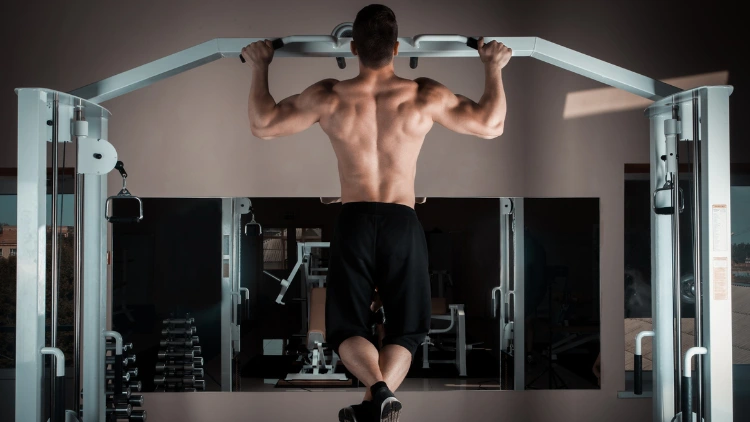
Source: takoburito via Canva.com10
For someone looking to develop a massive lat spread and popping biceps, this exercise is non-negotiable. Experiment with slowing down the eccentric portion of the exercise for an even deeper bicep burn.
Close Grip Pull Ups Muscles Worked
This challenging pull up variation is performed with the hands closer than shoulder distance apart. It activates the triceps, chest muscles, and shoulder muscles in particular.
The muscles targeted by close grip pull-ups include the rhomboids, deltoids, and teres major. Learn about the muscles activated during close grip lat pulldowns.
Neutral Grip Pull Up Muscles Worked
Neutral grip pull-ups require the use of parallel bars, which may not be available in every gym. If working out outside, the monkey bars at many playgrounds make a great substitute!
Also, there are some equipment add-ons available for purchase that can convert a regular pull-up bar into a neutral grip bar. In this grip, the palms face each other.
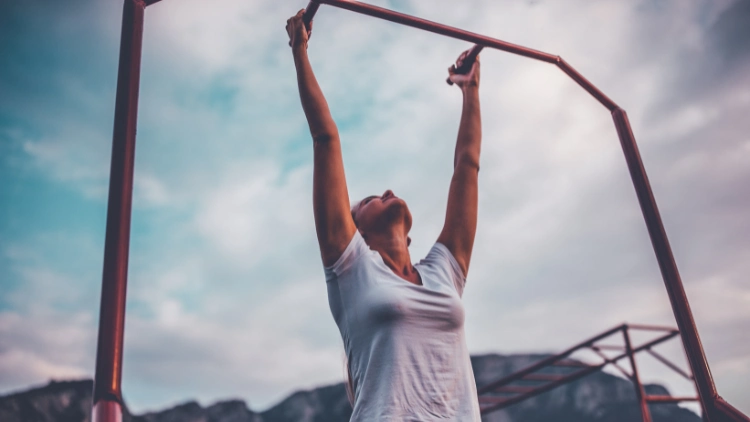
Source: Jecapix via Canva.com11
The neutral grip pull-up engages the chest muscles while also providing wrist and shoulder protection, making it an ideal variation for individuals with a history of joint injuries in those areas. Also, this variation may feel easier than the other variations listed here, which means it’s a great starting point for anyone new to pull-ups.
Overhand (Pronated) Grip Pull Up Muscles Worked
This is the pull-up variation most people would describe as a ‘normal’ pull-up. While all the muscles described above are engaged in this basic type of pull-up, it’s worth noting that a pronated grip pull-up engages the middle trapezius more than a neutral grip pull-up.12

Source: A’s Images via Canva.com13
The middle traps serve to stabilize and retract the shoulder blades, so this variation may be the ideal choice for anyone working on improving their posture.
Underhand (Supinated) Grip Pull Up or Chin Up Muscles Worked
A supinated grip pull-up is known by its more common name – a chin up! When discussing types of pull-ups and muscles worked, chin-ups need to be included in the conversation.
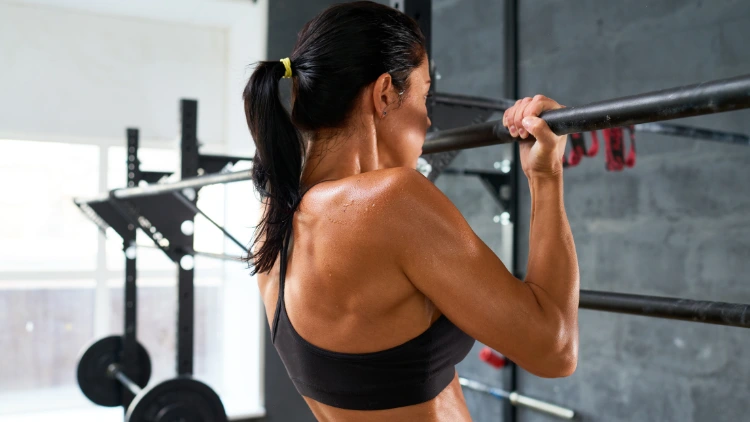
Source: mediaphotos via Canva.com14
This variation is easier than pull-ups for many people, and it may improve definition in the biceps and rear delts more than other pull-up types. Keep in mind that some research indicates that an underhand grip or a wide grip may increase the risk of shoulder impingement.15
While this shouldn’t be cause for alarm, it may be wise to avoid this variation if recovering from a shoulder impingement or associated injury.
Summary of How Different Grip Widths & Hand Orientations Affect Pull-Up Muscles Worked
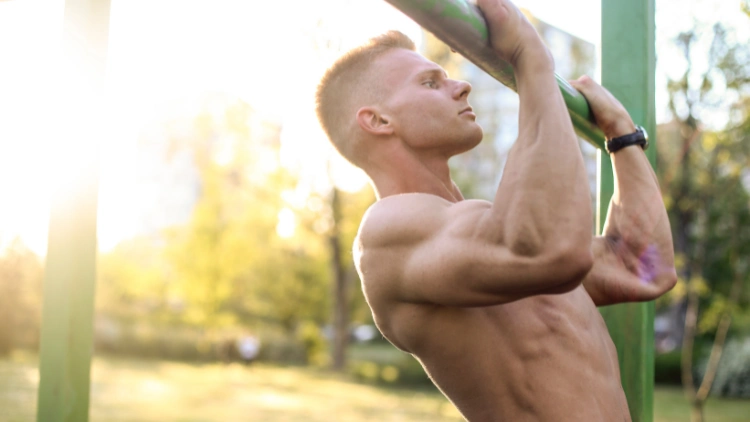
Source: GoodLifeStudio via Canva.com16
Let’s summarize pull-up muscles worked by type:
Wide Grip Pull Ups Muscles Worked
- Lats and biceps
- Slow down the lowering phase for even more bicep engagement
Close Grip Pull Ups Muscles Worked
- Triceps, pec muscles, and shoulder muscles
- Good for advanced lifters
Neutral Grip Pull Up Muscles Worked
- Pec muscles
- Easier and safer for beginners
Overhand (Pronated) Grip Pull Up Muscles Worked
- Middle traps
- May help improve posture and shoulder stability
Underhand (Supinated) Grip Pull Up or Chin Up Muscles Worked
- Biceps and rear delts
- Easier for beginners
Neutral Grip vs. Wide Grip vs. Narrow Grip vs. Supinated vs. Pronated: Which Is Superior?
While many lifters have participated in the age-old debate of pull up vs. chin up muscles worked, once all the other pull-up variations get thrown in, it gets a little more complicated. The question of which variation is superior comes down to an individual lifter’s goals, personal preferences, and injury history.
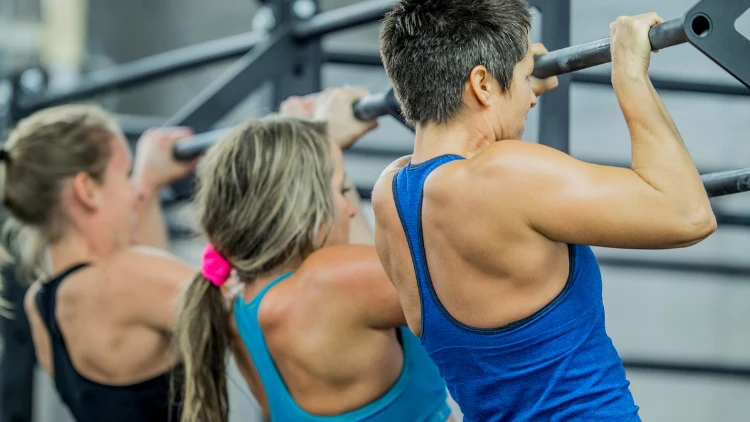
Source: FatCamera via Canva.com17
It’s important for everyone, regardless of their answers to those questions, to do pull-ups on at least a weekly basis and to incorporate as many pull-up variations into their exercise routine as possible. This will help them avoid plateaus, decrease the risk of overuse injuries, and develop dynamic, well-rounded strength.
Learn more about how to build muscle and gain strength using scientific principles that never change.
What Are the Top Benefits of Pull-Ups?
Let’s also explore the additional benefits of this powerful exercise, beyond just understanding the muscles engaged during pull-ups:
- Strength developed from pull-ups translates well to basic activities of everyday life.
- Pull-ups can help reduce back pain symptoms.
- Pull-ups will increase definition and strength in the core muscles.
- Improved grip strength from pull-ups makes other exercises and daily living activities easier.
- Compound exercises like pull-ups that engage multiple muscle groups at once are an efficient way for busy people to make the most of their workouts.
- It’s easy to measure progress on pull-ups, which is very motivating.
- Pull-ups don’t require special equipment or a complex set-up, and they’re easy to do at home with a doorway pull-up bar.
Potential Downsides of Pull Ups If Done Wrong, With Imbalances, or Injuries
Potential drawbacks of pull-up variations should be considered, even though most can be managed with care:
- Performing pull-ups with bad form can lead to shoulder or wrist issues.
- Some pull-up variations may not be the right choice for someone with a history of shoulder impingement or wrist problems.
- Pull-ups can increase neck pain or tension in people with weak traps, so it’s important to start slow and progress appropriately.
How To Perform Pull-Ups With Good Form & Prevent Injury
Let’s learn to perform pull-ups with good form and then take note of which muscles feel worked during the session, and fatigued or sore afterwards!
Here’s a step-by-step guide on how to do a perfect pull-up, even for people who have never done one before:
Step 1: Start with timed hangs to develop grip strength and get comfortable hanging from a bar. Always wrap the thumbs around the bar. Bend the knees or keep them straight, breathe steadily, and engage the upper back by drawing the shoulder blades together and down in an ‘un-shrug’ movement.
Try to maintain this shoulder and upper back engagement throughout the entire hang.
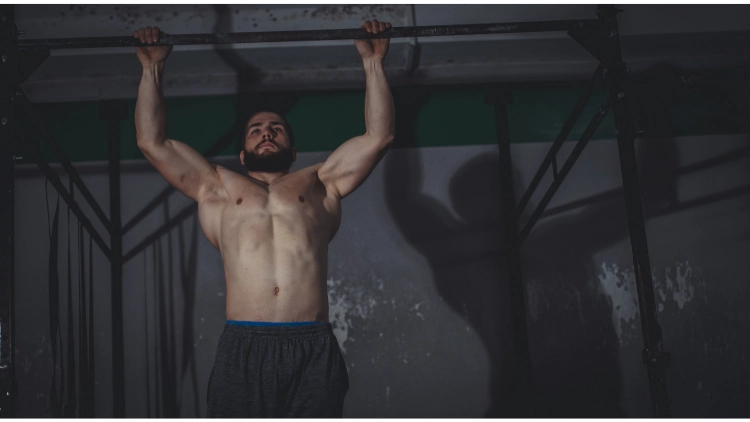
Source: South_agency via Canva.com18
Step 2: Once 3 sets of 30 second timed hangs feels comfortable, progress to 3 sets of 10 reps of shoulder depressions. Perform a ‘shrug/un-shrug’ movement with the shoulders, moving the shoulder blades up and down with each rep.
The elbows remain straight in this exercise. Keep the legs hanging straight down and look forward with a neutral neck (don’t look up or down).
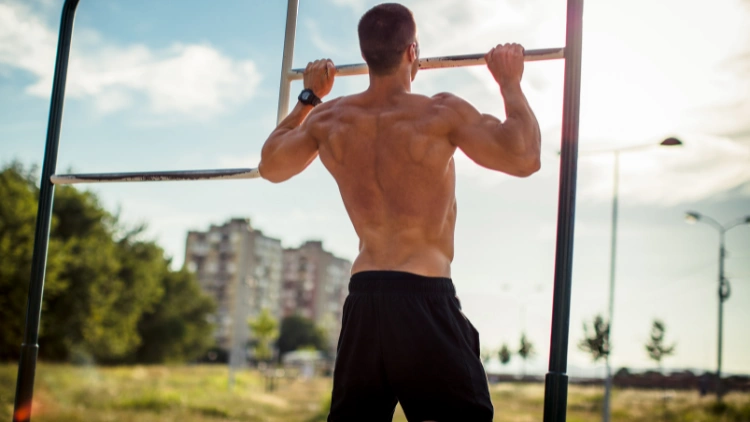
Source: eclipse_images via Canva.com19
Step 3: Start working on pull-up eccentrics/negatives! For those who are unable to complete a pull up, practicing the eccentric, or lowering phase of the movement is an excellent way to strengthen the back muscles and work towards an unassisted pull up.
Use a box or bench to step up into the top position of a pull-up, with the chest lined up with the bar and the knuckles lined up with the shoulders. Draw the shoulders down and back.
Lift the feet and straighten the arms as slowly as possible, lowering to a dead hang. Repeat 3 sets of 3-10 reps.

Photo by Mike González on Pexels20
Step 4: Introduce banded pull-ups. Once eccentric pull-ups feel manageable, move onto banded pull-ups. Loop a long, Crossfit-style exercise band around a pull-up bar and back through itself.
Use multiple bands or vary the thickness of the band(s) to achieve the appropriate level of assist. Grip the bar to either side of the band and have someone help stretch the band down so the lifter can rest their knee in it.
Perform a pull-up, drawing elbows straight down and lifting the chest to the bar. Pay attention to the previously mentioned cues regarding the shoulders, shoulder blades, and upper back muscles.
Lower with control until the arms are straight. Repeat 3 sets of 3-10 reps.
Pretty soon, the lifter will be able to graduate to pull-ups without an exercise band for support!
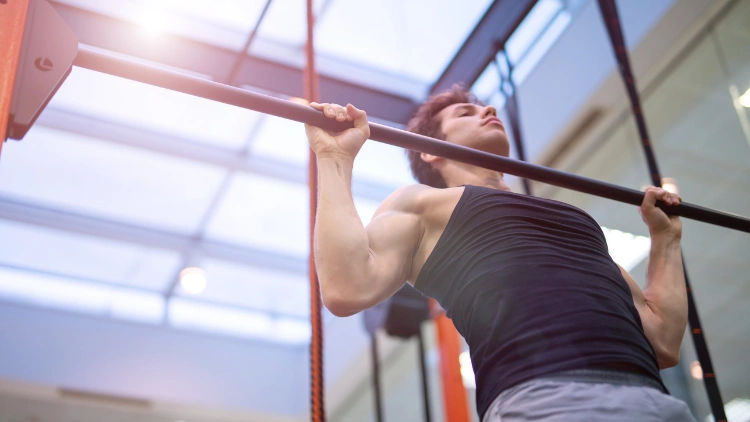
Source: Minerva Studio via Canva.com21
Time spent increasing the number of pull-ups a person can do is never time wasted and even more so because research shows that women who can perform pull-ups are typically leaner and stronger than those who can’t.22
Tip: If you don’t have a workout buddy or exercise bands, you can opt for an assisted pull-up machine or a cable (lat) pull-down machine instead. These machines offer benefits by providing an empirical way to track and advance your pull-ups as you work your way up to an unassisted pull-up.
Be sure to avoid these common pull-up mistakes:
- Don’t arch your back while performing a pull-up, unless you’re an advanced lifter who’s specifically trying to target the low back muscles. Instead, lift the chest and draw the shoulders and elbows down and back. Maintain engagement in the core throughout.
- Don’t lift your knees to the front while performing a pull-up or engage your abs.
- Don’t skimp on range of motion. Each rep should move from a dead hang with straight arms to fully locked off elbows with the chest at the bar.
Pull-Up Tips & Tricks for Neutral, Wide, Narrow, Underhand & Overhand Grips
Tip for Neutral Grip Pull Ups: It’s very important to lift the chest and avoid rounding the shoulders forward at the top of the movement.
Tip for Wide Grip Pull Ups: Be sure to warm up the shoulders thoroughly before performing, as this exercise requires more external rotation from the shoulders than the other variations listed. Also, start with straight elbows!
Many people cheat and start with slightly bent elbows in this variation.
Tip for Narrow Grip Pull Ups: Keep the wrists neutral and the shoulders drawn down and back. Look straight forward throughout the movement.
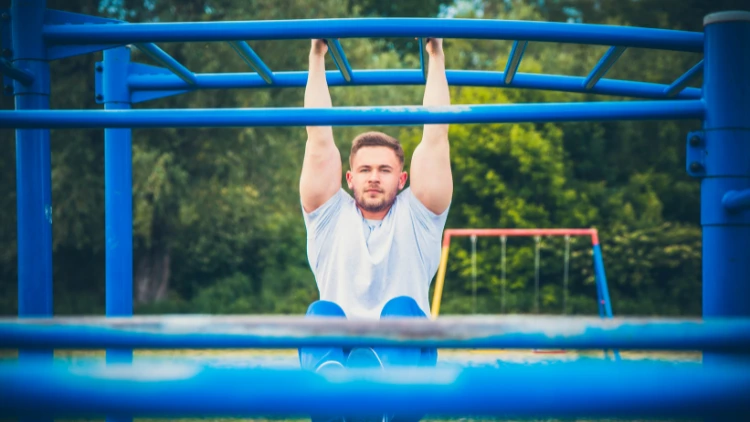
Source: LordHenriVoton via Canva.com23
Tip for Underhand Pull Ups or Chin Ups: Send the elbows down and back and aim for a slightly larger range of motion compared to overhand grip.
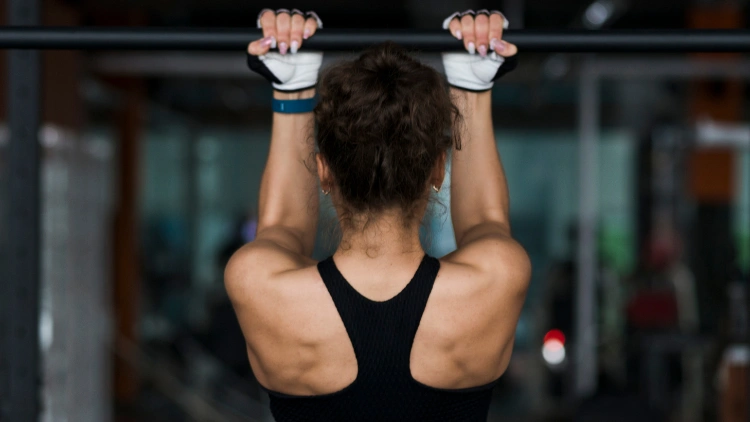
Image by Freepik24
Tip for Overhand Pull Ups: Keep the wrists neutral until these joints develop enough strength and mobility for movements like muscle-ups.
How Increase the Amount of Pull-Ups You Can Do
The best way to increase the amount of pull ups you can do is by consistently practicing to improve form, but you must also increase the load over time.
Here’s some ways to do that:
- Begin with scap pull ups (as seen above)
- Used an assisted pull up machine
- Do pull downs until you develop enough back strength
- Do banded pull ups
- Use a narrower grip which allows the biceps to engage more
- Experiment with different grip variations (some find underhand pull ups, also known as chin ups, to be easier)
- Try eccentric pull ups by standing on a box, getting your ahead above the bar, then raise your feet off the box and lower yourself down slowly
- If you can do 6-12 pull ups, begin using a pull up bar to add load. Start with 2.5 pounds and increase from there
- Stick with one variation (the one you can do the most pull ups with) for at least one training cycle of 4-8 weeks
- Incorporate rows, biceps curls, face pulls and other exercises that help to develop the lats and muscles in the mid-back
What To Do if You Experience Pain When Doing a Pull-Up
At some point in every lifter’s strength-building journey, an uncomfortable twinge or stubborn ache in a joint or two is inevitable. If pull-ups bother the wrists, shoulders, neck, or any other muscle groups, there are a few things everyone should do:
- Take a week off from the movement and see if the issue clears up on its own.
- Ask a personal trainer or experienced lifter to review your form and offer any feedback.
- Incorporate more stretching or warming up. This shoulder protocol to build strength and mobility is a great starting point.
- Work on improving recovery practices like sleep, hydration, stress management, and diet. These easy diets for back pain may help immensely.
- If none of these steps resolve the issue, consult with a licensed massage therapist, physical therapist, chiropractor, or orthopedic doctor to ensure that any underlying issues are dealt with appropriately.
While pull-ups are a challenging compound movement, they are an exercise that every lifter should include in their workouts. Now that you understand which muscles pull-ups target, head to the gym and start incorporating them into your workout routine today!
Frequently Asked Questions
What’s the Difference Between a Pull-Up vs. a Chin-Up?
In a pull-up, the hands grip the bar with an overhand, or pronated grip. In a chin-up, the hands grip the bar with an underhand, or supinated grip.
How Many Pull-Up Reps Should You Do Each Day?
It’s probably unwise to perform pull-ups more than two to three times per week. In a given workout, aim for 2-4 sets of maximum reps.
And be sure to read about what happens if you do 500 pushups a day.
Is It Okay To Do Pull-Ups Every Day?
Most exercise physiologists recommend against performing the same exercise every single day. Aim to include pull-ups in 1-3 workouts per week, focusing on other muscle groups on the days in between.
Should I Pull Up to My Eyes, Chin, Or Chest?
Everyone should work towards increasing their pull-up range of motion, regardless of where they’re currently at. Aim for consistency throughout a workout.
If you pull up to your chin on your first rep, you should also pull up to your chin on your twentieth rep.
Do Lat Pull Downs Target the Same Muscles as Pull Ups?
Muscles targeted during lat pull downs include the latissimus dorsi, biceps, trapezius, rhomboids, and rear deltoids. These same muscles are engaged in pull-ups as well, but pull-ups increase grip strength and core strength quicker than lat pull downs.
What Are the Key Differences in Pull Up vs. Chin Up Muscles Worked?
Chinups engage the pecs and the biceps more than pull-ups, while pull-ups engage the middle and lower trapezius more than chin-ups. It’s smart to include both variations in a workout plan to encourage balanced muscle development.
Which Muscles Are Engaged During Pull-Ups With an Arched Back?
By arching the back during a pull-up, advanced lifters may increase engagement in the erector spinae muscles in the low back. However, this variation is not recommended for people who are new to pull-ups.
References
1GoodLifeStudio. Canva. Accessed 21 April 2023. <https://www.canva.com/photos/MAEJMBTYwiQ-pull-ups/>
2microgen. Canva. Accessed 21 April 2023. <https://www.canva.com/photos/MADmvHFlXQk-woman-athlete-doing-pull-ups/>
3Negrete, R. J., Hanney, W. J., Pabian, P., & Kolber, M. J. (2013). Upper body push and pull strength ratio in recreationally active adults. International journal of sports physical therapy, 8(2), 138–144. <https://www.ncbi.nlm.nih.gov/pmc/articles/PMC3625793/>
4Science Photo Library. Canva. Accessed 21 April 2023. <https://www.canva.com/photos/MADq3vbyn-k-f017-1255/>
5Snarr, R. L., Hallmark, A. V., Casey, J. C., & Esco, M. R. (2017). Electromyographical Comparison of a Traditional, Suspension Device, and Towel Pull-Up. Journal of human kinetics, 58, 5–13. <https://doi.org/10.1515/hukin-2017-0068>
6Science Photo Library. Canva. Accessed 21 April 2023. <https://www.canva.com/photos/MADmTDg8VA4--shoulder-muscles/>
7Grebe, Hank. Canva. Accessed 21 April 2023. <https://www.canva.com/photos/MADZASGJL7w-labeled-anatomy-chart-of-neck-and-shoulder-muscles-on-white-background/>
8Dickie, J. A., Faulkner, J. A., Barnes, M. J., & Lark, S. D. (2017). Electromyographic analysis of muscle activation during pull-up variations. Journal of electromyography and kinesiology : official journal of the International Society of Electrophysiological Kinesiology, 32, 30–36. <https://doi.org/10.1016/j.jelekin.2016.11.004>
9Jun. Canva. Accessed 21 April 2023. <https://www.canva.com/photos/MADZ_yciTMg-strong-man-doing-pull-up-exercise-in-the-gym/>
10takoburito. Canva. Accessed 21 April 2023. <https://www.canva.com/photos/MADaqxaoOn8-pull-ups/>
11Jecapix. Canva. Accessed 21 April 2023. <https://www.canva.com/photos/MAEIrs7YIiQ-pull-ups/>
12Dickie, J. A., Faulkner, J. A., Barnes, M. J., & Lark, S. D. (2017). Electromyographic analysis of muscle activation during pull-up variations. Journal of electromyography and kinesiology : official journal of the International Society of Electrophysiological Kinesiology, 32, 30–36. <https://doi.org/10.1016/j.jelekin.2016.11.004>
13A’s Images. Canva. Accessed 21 April 2023. <https://www.canva.com/photos/MAE3K2unf10-muscular-man-doing-pull-ups-on-horizontal-bar/>
14mediaphotos. Canva. Accessed 21 April 2023. <https://www.canva.com/photos/MAEE1rLi1Es-strong-woman-doing-pull-ups/>
15Prinold, J. A., & Bull, A. M. (2016). Scapula kinematics of pull-up techniques: Avoiding impingement risk with training changes. Journal of science and medicine in sport, 19(8), 629–635. <https://doi.org/10.1016/j.jsams.2015.08.002>
16GoodLifeStudio. Canva. Accessed 21 April 2023. <https://www.canva.com/photos/MAEEoLekitY-chin-ups/>
17FatCamera. Canva. Accessed 21 April 2023. <https://www.canva.com/photos/MAEJN1Chim8-pull-ups/>
18South_agency. Canva. Accessed 21 April 2023. <https://www.canva.com/photos/MAEJOfE5pTY-doing-pull-ups/>
19eclipse_images. Canva. Accessed 21 April 2023. <https://www.canva.com/photos/MAEEE2vo8Ko-doing-pull-ups/>
20Gonzalez, Mike. Pexels. Accessed 21 April 2023. <https://www.pexels.com/photo/a-woman-doing-pull-ups-14623746/>
21Minerva Studio. Canva. Accessed 21 April 2023. <https://www.canva.com/photos/MAEHuYTZkUQ-man-doing-free-body-calisthenic-pull-ups-in-a-gym/>
22Flanagan, S. P., Vanderburgh, P. M., Borchers, S. G., & Kohstall, C. D. (2003). Training college-age women to perform the pull-up exercise. Research quarterly for exercise and sport, 74(1), 52–59. <https://doi.org/10.1080/02701367.2003.10609064>
23LordHenriVoton. Canva. Accessed 21 April 2023. <https://www.canva.com/photos/MAEI14IFtj0-man-doing-pull-ups-in-the-park/>
24“Free Photo | Back view woman performing pull-ups.” Freepik. Accessed 21 April 2023. <https://www.freepik.com/free-photo/back-view-woman-performing-pull-ups_2146557.htm>